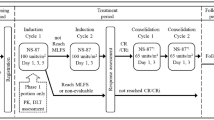The infiltrates of intracerebrally inoculated DBLA-6 leukemia cells of the rat were used as an experimental model of meningeal leukemia in acute leukemia. Systemic administration of an antileukemic agent (daunomycin) started at the early stage of the leukemic involvement in the arachnoid, when the blood-brain barrier (blood-cerebrospinal fluid barrier) was not yet broken in the pial microcirculation. In those animals in which the antileukemic agent alone was administered, leukemic infiltration was decreased in the dura while it was clearly observed in the subarachnoid space. In those animals in which the blood-brain barrier was damaged by acute angiotensin-induced hypertension, the chemotherapeutic effect on leukemic infiltration was markedly enhanced in the arachnoid and other parts of the brain. The blood-brain barrier dysfunction was analysed using the technique of fluorescein cine-angiography. The results indicated that the chemotherapeutic effect of the agent given systemically was impeded by the barrier, particularly in early arachnoidal infiltration of leukemic cells. Also, this in vivo experiment showed the importance of drug delivery to tumor cells growing outside blood vessels in cancer chemotherapy.
Similar content being viewed by others
References
Aoshima, M., and Sakurai, Y., 1972, Sensitivity of transplantable rat leukemia, DBLA-6, to antitumor agents. Gann, 63, 281–290.
Häggendal, E., and Johansson, B., 1972, On the pathophysiology of the increased cerebrovascular permeability in acute arterial hypertension in cats. Acta Neurologica Scandinavica, 48, 265–270.
Johansson, B., 1974, Blood-brain barrier dysfunction in acute arterial hypertension. Thesis from University of Göteborg, Göteborg, Sweden, p. 17.
Moore, E. W., Thomas, L. B., Shaw, R. K., and Freireich, E. J., 1960, The central nervous system in acute leukemia. Archives of Internal Medicine, 105, 451–468.
Odashima, S., and Fuei-Chang, Wang, 1970, Establishment of four lines of transplantable rat leukemia induced by N-nitrosobutylurea in Donryu rats. Gann, 61, 597–600.
Price, R. A., and Johnson, W. W., 1973, The central nervous system in childhood leukemia: 1. The arachnoid. Cancer, 31, 520–533.
Rosenblum, W. I., 1970, Effect of blood pressure and blood viscosity on fluorescein transit time in the cerebral microcirculation in the mouse. Circulation Research, 27, 825–833.
Sato, H., and Suzuki, M., 1977, Metastasis and chemotherapy, with reference to permeability of microcirculation system. Cancer Invasion and Metastasis: Biologic Mechanisms and Therapy, edited by S. B. Day, W. P. L. Myers, P. Stansly, S. Garattini and M. G. Lewis (New York: Raven Press), pp. 145–149.
Suzuki, M., 1968, Studies on metastasis XXIV: Experiments on the brain metastasis of the rat ascites hepatoma cells. Kosankinbyo-Kenkyu Zasshi, 20, 181–194.
Suzuki, M., Hori, K., Abe, I., Saito, S., and Sato, H., 1980, Experimental study on characteristics of microcirculation in tumor tissue, with reference to cancer chemotherapy. Metastasis: Clinical and experimental aspects, edited by K. Hellmann, P. Hilgard and S. Eccles (Hague: Martinus-Nijhoff), pp. 356–360.
Suzuki, M., Hori, K., Abe, I., Saito, S., and Sato, H., 1981, A new approach to cancer chemotherapy: Selective enhancement of tumor blood flow with angiotensin II. Journal of the National Cancer Institute, 67, 663–669.
Suzuki, M., and Sato, H., 1977, Experimental studies on local penetration of anticancer drugs in tumor tissue. Cancer Chemotherapy, 4 (Suppl.), 97–102.
Suzuki, T., Tominaga, S., Strandgaard, S., and Nakamura, T., 1975, Fluorescein cineangiography of the pial microcirculation in the rat in acute angiotensin-induced hypertension. Blood Flow and Metabolism in the Brain, edited by M. Harper, B. Jennett, D. Miller and J. Rowan (Edinburgh: Churchill- Livingstone), 5·8–5·9.
Thomas, L. B., Chirigos, M. A., Humphreys, S. R., and Goldin, A., 1962, Pathology of the spread of L 1210 leukemia in the central nervous system of mice and effect of treatment with cytoxan. Journal of the National Cancer Institute, 28, 1355–1389.
Author information
Authors and Affiliations
Rights and permissions
About this article
Cite this article
Suzuki, M., Abe, I. & Sato, H. Changes in drug delivery (by blood-brain barrier dysfunction) on arachnoid leukemia: implication for CNS leukemic dissemination. Clin Exp Metast 1, 163–171 (1983). https://doi.org/10.1007/BF00121495
Received:
Accepted:
Issue Date:
DOI: https://doi.org/10.1007/BF00121495




